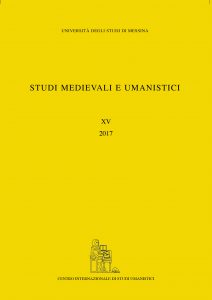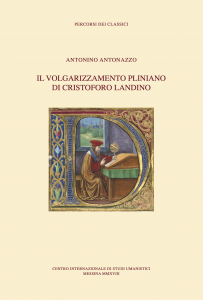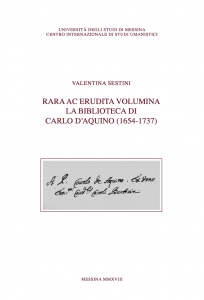
XV (2017)
Messina, Centro Internazionale di Studi Umanistici, 2017, 591 pp.; 25 cm.
ISSN 2035-3774
€ 80
INDICE GENERALE
Dedica
Da Messina a Verona
Caterina Malta, «Pretransformari studeo». In margine a Triumphus Fame I
Michelangelo Zaccarello, «Come d’asse si trae chiodo con chiodo» (Triumphus Cupidinis III 66). Un’immagine di Petrarca fra Cicerone e Dante
Carla M. Monti, Gli esordi del pensiero politico signorile di Petrarca: i testi per Azzo da Correggio e Luchino Visconti
Aurelio Malandrino, Intorno ai codici petrarcheschi latini della Biblioteca Marciana
Fabio Forner, Petrarca a Verona: alcune considerazioni sui manoscritti petrarcheschi della Biblioteca Capitolare e della Biblioteca Civica
Lisa Ciccone, Petrarca parum prudens in un commento quattrocentesco all’Ars poetica di Orazio
Arnaldo Soldani, La forma sintattica dei sonetti di Sannazaro
Laura Facini, Il petrarchismo di Garcilaso. Alcune letture intertestuali (sonn. IV, XII, XV, XXII, XXVI)
Massimo Natale, Tasso e le canzoni degli occhi: in margine a Rime 1449-1451
Giovanni Cascio, Francesco Petrarca tra Jakob Heerbrand e Sigmund Ernhoffer: un episodio della ‘fortuna’ del Liber sine nomine nell’Europa della Riforma
Uberto Motta, Il gentiluomo innamorato: Petrarca, Castiglione, Shakespeare
Luca Mazzoni, Il Petrarca sconosciuto: l’edizione bodoniana di Rerum Vulgarium Fragmenta e Triumphi (1799)
Antonio Rollo, Un Tetravangelo appartenuto a Manuele Crisolora e una nota con la sua data di nascita
Antonino Antonazzo, Gli excerpta pliniani di Landino
Stefano Pagliaroli, Giano Lascari, Venezia, Mantova e uno sconosciuto θησαυρός di lettere autografe
Paola de Capua, Tra Giano Vitale, Pietro Corsi e Niccolò Ridolfi
Giovanni Cascio, Due prolusioni di Demetrio Calcondila nella biblioteca di Hartmann Schedel
Indice dei manoscritti e delle fonti d’archivio
Indice dei nomi
ABSTRACT
Caterina Malta, «Pretransformari studeo». In margine a Triumphus Fame I
The article proposes a new critical text of the marginal notes added by Petrarch at the beginning of his original working copy of Triumphus Fame I and borne witness to in 16th-century copies. The textual restoration makes it possible to offer a more certain interpretation of their metapoetic meaning. The annotations are thus connected to the Augustinian theme of mutatio, in line with the moral and philosophical developments in the post-Secretum period.
Michelangelo Zaccarello, «Come d’asse si trae chiodo con chiodo» (Triumphus Cupidinis III 66). Un’immagine di Petrarca fra Cicerone e Dante
Among the exempla of lovers cited in Triumphus Cupidinis (III 66), Petrarch describes the Persian king Assuero marrying the prophetess Esther as «pulling a nail out of the wood with another nail»; in their order, the succession of rhyme-words that he uses hints at a direct reprise of the famous dialogue between Dante and Bonagiunta Orbicciani on the advent of a new lyric poetry (Purg. XXIV 51-57). Collecting various examples of this metaphor, from Greek literature to the Bible, from Cicero to Carmina Burana, this essay attempts to assess the general value of its meaning, with special attention to Dante. In a letter by St Jerome, the new love object introduced by the nail metaphor is deemed more deserving that the abandoned one; conversely, the lover moves on to a new feeling through a process of moral regeneration. The essay suggests that, via the nail metaphor, the Dantean view of the ‘sweet style’ may also be read in the same terms.
Carla M. Monti, Gli esordi del pensiero politico signorile di Petrarca: i testi per Azzo da Correggio e Luchino Visconti
Petrarch’s political thought is plainly in favour of the signory and this is well apparent from texts he wrote for Azzo da Correggio and Luchino Visconti, where the reasons of his disputed decision to live in Milan are made clear. The basic points are: monarchical government is better than government of many factions; political horizon must not sight city-state but Italy; supreme good to be pursued is peace; the prince has to be literate and protector of men of letters. Texts discussed are Dispersa 21, RVF CXXVIII, Fam. III 7 and VII 15, Epyst. II 11 and III 6.
Aurelio Malandrino, Intorno ai codici petrarcheschi latini della Biblioteca Marciana
The article introduces the census of all the manuscripts bearing Petrarch’s Latin works stored in the Marciana Library. The census is a fundamental resource in order to reconstruct the diffusion of Petrarch’s works and to carry out an exhaustive recensio. Moreover, the analytical description of the codices has produced many discoveries not dealing with Petrarch, such as an unknown miscellaneous manuscript written by Marin Sanudo and a letter which seems to testify the diffusion of Dante’s epistolography in Messina at the beginning 15th century.
Fabio Forner, Petrarca a Verona: alcune considerazioni sui manoscritti petrarcheschi della Biblioteca Capitolare e della Biblioteca Civica
Some, not very many, manuscripts, that hand down the Latin and Italian works of Petrarch, are preserved in the Biblioteca Capitolare and in the Biblioteca Civica of Verona. The Italian manuscripts usually contain the entire work of Petrarch, they are for the most part in parchment, written by well-known copyists, and embellished with miniatures and gilded friezes; they are linked to the names of famous Veronese humanists, first Felice Feliciano. As for the Latin works, we are faced with a tradition mainly per excerpta. This tradition gives an account of the long-lasting success of the moral writings of Petrarch.
Lisa Ciccone, Petrarca parum prudens in un commento quattrocentesco all’Ars poetica di Orazio
This article concerns a gloss about Petrarch transmitted by two manuscripts: Milano, Bibl. Ambrosiana, I 38 sup. and Firenze, Bibl. Riccardiana 3594. The gloss, which is part of an anonymous commentary on Horace’s Ars poetica, produced in the second part of XV century, says that Petrarch was «parum prudens», because «postquam Bucolicam edidit, ad plures scripsit qui versus quosdam corrigerent». The text contained in each of two manuscripts is probably a copy of notes derived from the same commentary explaned by a Guarino’s pupil. Finally, it is pointed out that the commentaries have some interesting glosses in common with the Martino Filetico’s exegesis on the same Ars poetica.
Arnaldo Soldani, La forma sintattica dei sonetti di Sannazaro
Sannazaro’s sonnet moves between two definite and apparently opposite stylistic characterisations. On the one hand it shows a classical attention to the deep features of the metrical form and its balance, that is to say a frequent and very aware assumption of a conventional syntactic structure. On the other hand it shows an extraordinary ductility and articulation of the discursive line, in each case adapted to the needs of the argumentation.
Laura Facini, Il petrarchismo di Garcilaso. Alcune letture intertestuali (sonn. IV, XII, XV, XXII, XXVI)
The poet of Toledo, Garcilaso de la Vega, is closely related to the circle of Neapolitan poets of the early sixteenth century. The article includes a preliminary introduction about the Spanish author – his life, works and cultural context – and then focuses on a comparative analysis of five sonnets in relation to some texts of Tebaldeo, Sannazaro, Tansillo, Aquilano, Cariteo, Bernardo Tasso, of the first model Petrarch, of his Spanish friend Juan Boscán, and other poets. The study shows the figure of an author who proves to not give in to an easy imitation, banal and obvious, but instead suggests a personal style without ever leaving the Neapolitan cultural domain.
Massimo Natale, Tasso e le canzoni degli occhi: in margine a Rime 1449-1451
The aim of the article is to analyse three Torquato Tasso poems, which are a sort of rewriting of the well known Francesco Petrarca’s cantilenae oculorum. Duly reinserted into his historical and philological frame, the texts will be the object of a thematic and intertextual examination, whose key expedient is the replacement of the main element of Petrarca’s lyrics – the eyes – with the beloved woman’s hands. In addition to a comparison with the figurative tradition, in which the role of the hand assumes a central importance throughout the entire Renaissance, the intervention focuses on the ‘logic of challenge’ that constitutes the core of the sequence: in competition with the Petrarchan pattern, the author displays here an original, personal ‘poetics of praise’.
Giovanni Cascio, Francesco Petrarca tra Jakob Heerbrand e Sigmund Ernhoffer: un episodio della ‘fortuna’ del Liber sine nomine nell’Europa della Riforma
The article aims to shed light on a little-known episode of the reception of Petrarch’s Liber sine nomine in the context of the theological controversies between Catholics and Protestants at the end of the 16th century. Petrarch’s anti-curial letters became a battleground between the Reformed theologian Jakob Heerbrand and the Jesuit Sigmund Ernhoffer. The contribution offers a glimpse of the forms and methods both of Petrarch’s recruitment as a forerunner of the Reformation by the Protestant intellectual, and of the defense of his doctrinal correctness advanced by a Catholic intellectual.
Uberto Motta, Il gentiluomo innamorato: Petrarca, Castiglione, Shakespeare
In Italian and European Renaissance, Petrarch is a model of poetic style as of behavior and manners, chiefly in love affairs; and his Canzoniere is received as a repertoire of sentiments and ideals from time to time adopted, recommended, censored. To illustrate the dynamics involved in this cultural system, a comparison is here proposed between three famous texts. That is the 16th sonnet of the Canzoniere, Movesi il vecchierel canuto et biancho, of chapters 66-69 of the IV book of The Book of the Courtier by Baldassarre Castiglione, and of the first act of Shakespeare’s Romeo and Juliet.
Luca Mazzoni, Il Petrarca sconosciuto: l’edizione bodoniana di Rerum Vulgarium Fragmenta e Triumphi (1799)
The edition of Rerum vulgarium fragmenta and Triumphi published in 1799 by Bodoni and edited by Giovanni Iacopo Dionisi and Bartolomeo Perazzini has been quickly forgotten by scholars. In the fisrt part of my essay I reconstruct the history of this edition, with some information coming both from the recently-published letters of the two Veronese scholars and from some unpublished letters. In the second part, I analyse the Introduction of the edition, in which some textual and exegetical issues are posed.
Antonio Rollo, Un Tetravangelo appartenuto a Manuele Crisolora e una nota con la sua data di nascita
This paper focuses on a Tetraevangelium (Par. gr. 67) bearing the usual Greek-Latin title that refers to Manuel Chrysoloras’ library. The manuscript also contains a chronological note recurring in MS Vat. gr. 1299. The connection of this note with an epitaph composed for Chrysoloras’ death allows to establish the date of his birth.
Antonino Antonazzo, Gli excerpta pliniani di Landino
This article examines Cristoforo Landino’s autograph manuscript Ricc. 154: it reveals a wide collection of excerpts from Pliny’s Naturalis historia, as a result of a systematic perusal of the whole encyclopedia. The A. locates the stemmatic position of the plinian source, illustrates the humanist’s method of compilation and proposes a chronology.
Stefano Pagliaroli, Giano Lascari, Venezia, Mantova e uno sconosciuto θησαυρός di lettere autografe
The essay illustrates the discovery in the State Archive of Mantua of a wide, friendly, unknown exchange of letters between Ianus Lascari and the marquis Franciscus II Gonzaga. It allows us to fill a large lacuna for the years 1503-1509 in the biography of the Byzantine humanist, who busily worked to promote aid to his countrymen. The correspondence is in Italian vernacular and very rich in public and private news. Many of Lascari’s letters are autograph and all bear his calligraphic signature.
Paola de Capua, Tra Giano Vitale, Pietro Corsi e Niccolò Ridolfi
By the examination of a large number of literary texts still now unknown the paper reconstructs the relationship between the Italian humanist Pietro Corsi and the French court, including the role of the cardinal Gabriel de Gramont, and clarifies a literary polemic produced in Rome whose protagonists were Corsi, the cardinal Niccolò Ridolfi and the Palermitan humanist Giano Vitale. In the paper’s Appendix the author gives the edition (with Italian translation) of three poems still unpublished: the elegy dedicated from Pietro Corsi to Niccolò Ridolfi; the fake and ironic reply, from ps. Ridolfi to Corsi; the final Corsi’s apologia composed by Giano Vitale.
Giovanni Cascio, Due prolusioni di Demetrio Calcondila nella biblioteca di Hartmann Schedel
The article focuses on two inaugural orations in praise of the Greek language and literature by the Byzatine émigré Demetrius Chalcondyles delivered at the University of Padua in the years 1463-64. This contribution’s primary aim is to offer a renewed critical edition of these academic speeches on the basis of the two surviving manuscripts (Munich, Bayerische Staatsbibliothek, Clm 350 and 28128), both transcribed and owned by the Bavarian humanist Hartmann Schedel. The critical text is introduced by an ample historico-cultural framework and accompanied by the first Italian translation.



